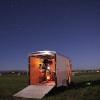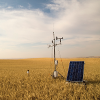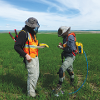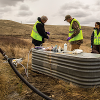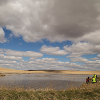Environmental Monitoring & Remote Sensing


Researchers

Andrew Laskowski is an assistant professor in the Earth Sciences Department and is a structural geologist with expertise in continental tectonics, deformation of the Earth’s crust, and relationships between geologic structure and economic resources. Dr. Laskowski is interested in the tectonic processes that create and destroy mountain belts. His research integrates geologic mapping and structural analysis with detrital and igneous U-Pb geochronology, (U-Th)/He thermochronology, and metamorphic petrology to test and/or create tectonic models. He is involved in field-based research focused on extension dynamics, continental subduction, and the suturing process in the western United States and southern Tibet (Xizang), China. Dr. Laswoski is also involved in research that applies detrital zircon geochronology to test provenance, determine maximum depositional ages, and track changes in the geochemistry of magmatism throughout the orogenic cycle.

Berk Knighton is a Research Professor in the Chemistry and Biochemistry Department. He has been actively involved in the development and application of chemical ionization mass spectrometry for nearly 20 years. That interest continues today and is primarily focused on using drift tube reaction mass spectrometry for the quantification of trace level volatile organic compound (VOC) emissions from a wide variety of natural and anthropogenic sources.
Dr. Knighton can be reached at 406-994-5419 or [email protected].
Website: http://www.chemistry.montana.edu/people/knighton-berk.html
Scott Powell is an assistant professor in the Land Resources and Environmental Services Department. Research in our group seeks to integrate geospatial data and tools (remote sensing, GIS, and GPS) to develop monitoring systems that characterize landscape and vegetation patterns to improve understanding of ecosystem processes and drivers. Our research contributes to the development of monitoring systems at a variety of scales (from site to continental) and across a variety of applications across the broad field of environmental science.
Dr. Powell can be reached at 406-994-5017 or [email protected].

Kevin Repasky is an associate professor in the Electrical and Computer Engineering Department and an affiliate assistant professor in the Physics Department. His areas of expertise include laser research and development, laser remote sensing, electro-optics, feedback and control, and optical technology development for communications.
Dr. Repasky can be reached at 406-994-6082 or [email protected].
Website: http://www.montana.edu/krepasky/
Joe Shaw is a professor in the Electrical and Computer Engineering Department. He is also the Director of the Optical Technology Center. Dr. Shaw designs, builds, and calibrates optical remote sensing systems and uses them to explore the natural Earth environment. From infrared imaging of clouds to laser detection of fish, optical remote sensing helps answer intriguing scientific questions while providing fascinating engineering challenges.
Dr. Shaw can be reached at 406-994-7261or [email protected].
Website: http://www.montana.edu/jshaw/index.html
Paul Stoy is an assistant professor in the Land Resources and Environmental Sciences Department. His research interests are surface-atmosphere exchange of water, energy, and trace gases with an emphasis on plot scale measurements and regional and global scale synthesis. Specific interests including quantifying the impacts of land use change and climate change on the surface energy balance, the carbon cycle, and hydrology in temperate, boreal, and arctic ecosystems.
Dr. Stoy can be reached at 406-994-5927 or [email protected].
Website: http://landresources.montana.edu/dept/faculty/stoy-p.html
